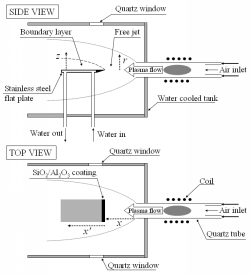Boundary layer analysis in air plasma
by laser diagnostics
and optical spectroscopy
 Abstract
Abstract
During the hypersonic atmospheric entry of a space probe in a planetary atmosphere,
the thermal protection system encounters heat flux densities up to 1 MW/m2 due to the radiation,
the convection and the chemical reactions occurring behind the shock front.
This medium is reproduced in laboratory using an inductively-coupled plasma (ICP) torch
to study the interaction of high-enthalpy plasmas with materials.
In the frame of this study, the boundary layer over a water-cooled stainless steel plate
in an air plasma was analysed by determining temperatures and densities of the majority molecular species N2, O2 and NO.
Laser and spectroscopy techniques allowed to demonstrate the non-equilibrium behaviour of the plasma and the production of NO close to the wall.
 Working conditions
Working conditions
- Inductively-coupled plasma (h = 9 MJ/kg)
- Mixture: synthetic air (80% N2 – 20% O2)
- Mass flow rate: 2.4 g/s
- Chamber pressure: 3800 Pa
- Jet velocity: 250 m/s
- Temperature in the free jet : 3000 K
- Leading edge position: x = 80 mm
|

|
 Diagnostic techniques
Diagnostic techniques
Objectives: Temperatures (Tvib,Trot) and Densities.
LIF (laser-induced fluorescence): NO (X)
OES (optical emission spectroscopy): NO (A)
SRS (spontaneous Raman spectroscopy): N2 (X), O2 (X)
 Non-equilibrium between ground and excited states
Non-equilibrium between ground and excited states
|
Measurements of rotational temperature made by various techniques on N2, O2 and NO
show coherent result for ground states in agreement with the translational temperature.
For the excited levels, the equality between Trot and Ttrans is not valid because
they are created by excitation exchange for example with the metastable state of N2 in the case of NO.
Ttrans can not be measured by OES in this case.
|

|
 Vibration – Rotation non-equilibrium
Vibration – Rotation non-equilibrium
|
Whatever the species (N2, O2, NO on their ground states),
vibrational and rotational temperatures are not equal in the free jet as well as within the boundary layer.
This result was expected for N2 because of its long vibrational relaxation time but unexpected for O2 and NO.
The outcome is that each vibrational mode should me modelled separately in a calculation.
|

|
 NO production at the wall and in the gas
NO production at the wall and in the gas
Equilibrium and frozen chemistries are not able to explain the behaviour of NO and O2 densities within the boundary layer.
The density measurements confirm both way of NO production: a catalytic one at the wall
Ogas + Nadsorbed → NOgas
and a homogeneous one along the Zel'dovich reaction
O2 + N → NO + O
following oxygen recombination at the wall.
|

|

|
 References
References
|
- D. Studer, P. Vervisch – "Raman scattering measurements within a flat plate boundary layer in an inductively coupled plasma wind tunnel." Journal of Applied Physics (2007), 102, 033303
- D. Studer, P. Boubert, P. Vervisch – "Demonstration of NO production in air plasma–metallic surface interaction by broadband laser-induced fluorescence." Journal of Physics D: Applied Physics (2010) 43 315202
- D. Studer, P. Boubert, P. Vervisch – "NO excitation and thermal non-equilibrium within a flat plate boundary layer in an air plasma." Lasers and Optics (2010)
|
 Related pages in this website
Related pages in this website
 The CORIA 100 kW ICP torch
The CORIA 100 kW ICP torch
 Inductively-coupled plasmas in aerospace research
Inductively-coupled plasmas in aerospace research

|

